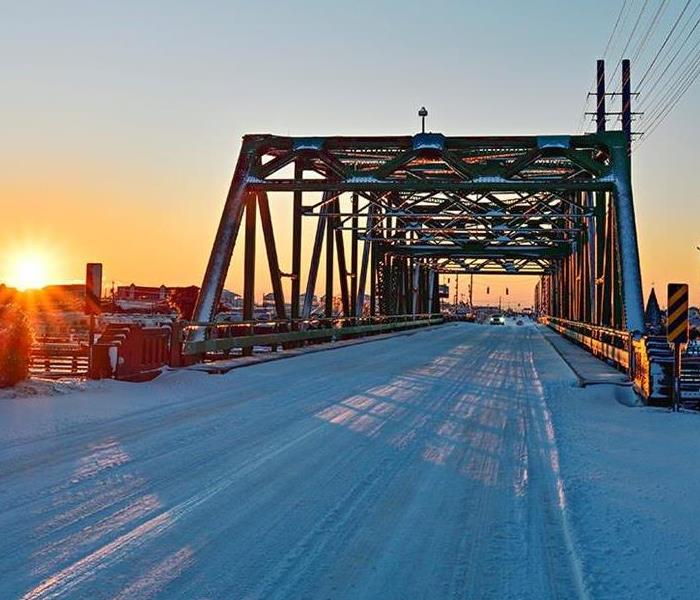Preparing Your Coastal Carolina Home for Winter
11/1/2019 (Permalink)
The weather is cooling off; the leaves are changing, and the holidays are quickly approaching. All these things mean that it’s time to make that list of winter preparations for your home and start checking them off! We have compiled a list of things that will need attention whether you are staying in your coastal home through the winter or if you are leaving. You should plan to complete this process in late November to early December.
- General Exterior Tips
- Clean the gutters and downspouts—This is essential because ice build up on leaves and debris can freeze and cause excess weight that will add weight and volume that can increase the potential for damage.
- Inspect Siding, Flashing, Windows, Doors and Roof—This is a great opportunity to do a visual inspection of the siding for cracks and gaps. Check your flashing for leaks and your roof for missing shingles. Not only will this prevent damages, but you can fill those gaps with caulk to help keep the interior of your home well insulated. Check the weather stripping around your doors, and on a windy day see if any air is entering your home around your windows. Fill any gaps with caulk to prevent drafts that will increase your heating bill.
- Winterize your Air Condition Unit/Remove window AC Units- Now is the perfect time to clean the condensing unit (the big air conditioning unit outside your house) of the AC System. Remove any large pieces of debris and use a high-pressure hose to rinse any residual debris off the blade and the condensing coils. You may want to consider purchasing a breathable waterproof AC cover to protect the unit and add longevity to the unit.
- Trim any tree limbs, dead trees and foliage against your home—Ice and snow can weigh down the limbs of dead trees and make them fall, which could cause significant damage to your home, fences, or car. You may be comfortable doing this on your own, but you may want to consider hiring a professional. Additionally, you should trim any foliage that is up against the home. Foliage allows moisture to sit up against the foundation and siding of your home for prolonged periods of wet weather.
- Prepare your outside space—Drain hose pipes, cover or bring in outdoor furniture and consider giving your deck a fresh coat of weather protectant sealant. Leaving your furniture outside and uncovered will deteriorate the quality quicker as well as the potential for those items to be damaged. You should also winterize your sprinkler system at this juncture—turn off the water supply, and blow out the sprinkler lines to prevent freezing, cracking or bursting.
- Inspect all water pipes that may be vulnerable—Insulate any exposed water or drainpipes in attics, crawlspaces and outside walls. Wrapping the pipes with foam. Insulate any exterior outlets and switch plates with foam insulation.
- General Interior Tips
- Flush out and insulate your water heater—Open the drain valve located near the bottom of your water heater to let the sediment run out and keep it functioning optimally. Insulate your hot water tank with an insulating blanket to increase the efficiency of the water heater.
- Test/maintenance on Heating system—Set the thermostat to an unusually high number (80 degrees)-Once you hear the furnace turn on, check to make sure that warm air is
blowing out of the vents. If necessary, schedule maintenance. Replace your air filters. This is also a good time to vacuum vents and baseboard heaters to avoid the burning dust smell. If you were considering buying a programmable thermostat, this may be a good opportunity to take that plunge as well. You can set the thermostat to not heat the home when no one is there, and some are even controllable remotely with your phone. Refuel any propane tanks necessary for usage. Test your carbon monoxide detector to ensure it is functioning properly.
- Chimney maintenance—Before using your fireplace for the first time, make sure to inspect it for any debris or nests. Open and close the flue to verify that it is functioning properly. Inspect the bricks and mortar joints of a brick chimney and have any openings repaired. It is also worth considering hiring a chimney sweep to properly clean the chimney.
If you are going to be vacating your property, there are additional precautions that need to be taken:
- Vacant Home Tips:
- Prepare and protect your plumbing—Completely turn of the water supply, drain your pipes by opening all faucets and flushing all toilets to empty the water from the tank and bowl. At this juncture you could hire a plumber to blow compressed air through the pipes to ensure they’re completely drained. If you do not drain the pipes keep your thermostat at 55 degrees which will keep the interior temperature-the floor and wall cavities where the piping is located above freezing temperatures.
- Prevent against pests—Clean your home thoroughly, including refrigerators, freezers and oven. Do a thorough inspection of all windows, doors and chimneys to be sure that they are sealed completely and capped to prevent intrusion.
- Routine Maintenance—This is a good time to perform the routine maintenance on the appliances in your home such as your HVAC, and an electrical inspection if the home is older. Additionally, cleaning out gutters and visual inspection of the roof as well as inspecting the weather stripping and insulation of the doors and windows will protect the home. It is also important to remove any dead trees or overhanging limbs that are close to the home to prevent against damages from ice or blustery wind gusts.
Winterizing your home will likely prevent costly repairs and escalated deterioration of your property. A little bit of time and sweat equity is all it takes to reduce these risks.






 24/7 Emergency Service
24/7 Emergency Service
